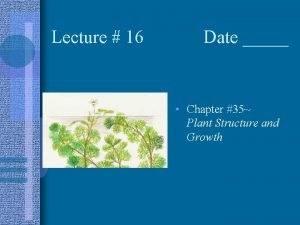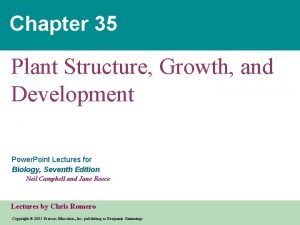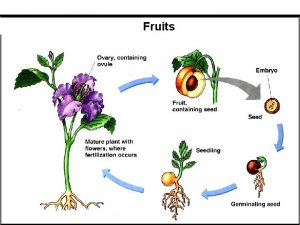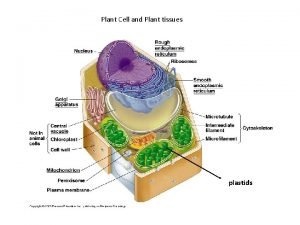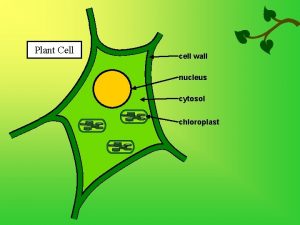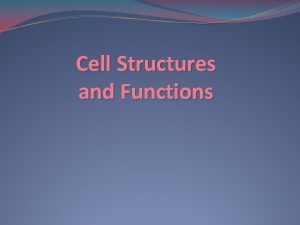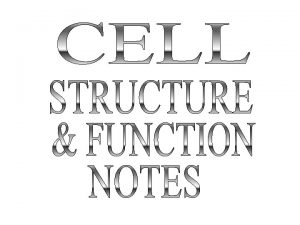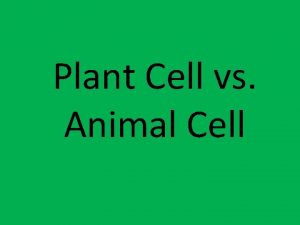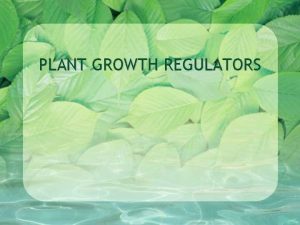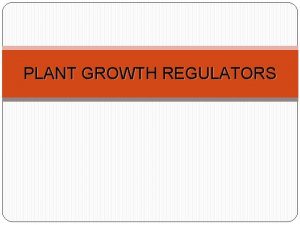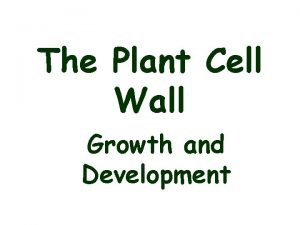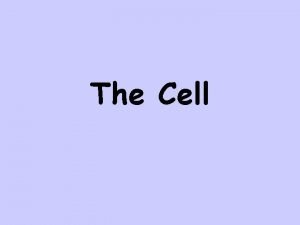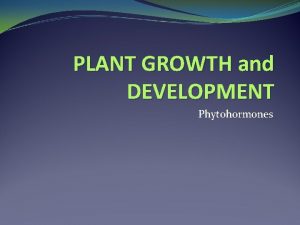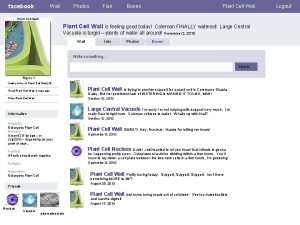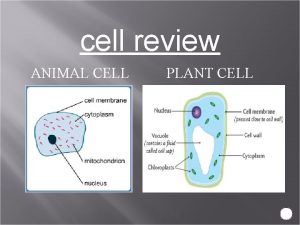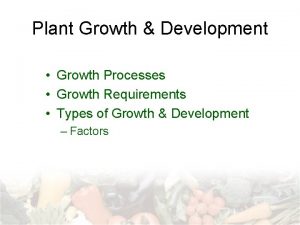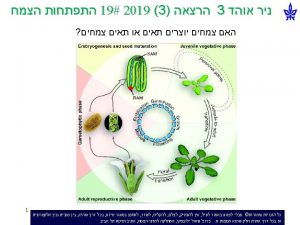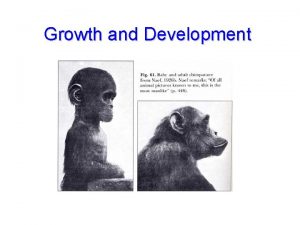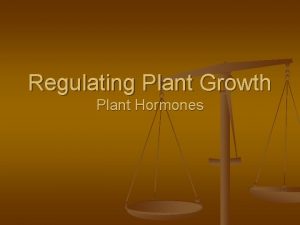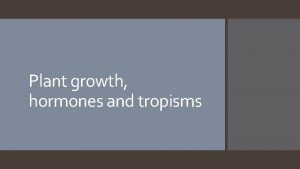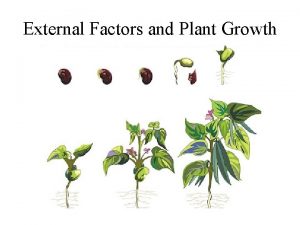The Plant Cell Wall Growth and Development From





























- Slides: 29

The Plant Cell Wall Growth and Development


From: Biochemistry and Molecular Biology of plants


Acid Growth hypothesis This is dependent on the growth hormone auxin. Auxin activates a plasma membrane proton pump, which acidifies the cell wall. Experimentally, H-ions have the same effect as auxin – so lowering the p. H is a good substitute. The lower p. H, in turn, activates growth-specific enzymes that hydrolyze the bonds holding the cellulose microfibrils to xyloglucan. The cleavage of these bonds results in the loosening of the cell wall. Causes uptake of water – which leads to a passive increase in cell size. From: Biochemistry and Molecular Biology of plants

Wall-loosening enzymes Expansins: Break hydrogen bonds between cellulose and xyloglucan. They are the only proteins shown to the active expansion of cell walls in vitro. They are always present in growing tissue of all plant cell material. When expansins are added to a heat-inactivated stem sample at acidic p. H, cell wall extension is restored. From: Biochemistry and Molecular Biology of plants

For a plant to grow: • new wall material has to be laid down as the cell expands New cellulose microfibrils are made as the cell expands. Plasma membrane These line up perpendicular to the direction of growth. As this happens the existing wall has to be loosened. From: Biochemistry and Molecular Biology of plants

Enzymes break the bonds holding xyloglucan to cellulose. Enzymes break the xyloglucan molecules. Other enzymes break the pectin Molecules (NOT SHOWN). The cell is now free to expand in a given direction. From: Biochemistry and Molecular Biology of plants

When expansion has stopped: Enzymes form new xyloglucan Molecules which re-attach to the Cellulose microfibrils. Also form New cross-links with newly formed Cellulose microfibrils. Cell wall proteins lock the cells new shape as these new wall components are being made. From: Biochemistry and Molecular Biology of plants

Plant Development.

Major Stages of Plant Development Germination: Occurs in response to the environment. This is driven by food (sugars) that are stored within the seed. This continues until photosynthesis starts. Roots extend downwards and the leaf-bearing shoots extend upwards. First leaves formed - cotyledons.

Meristematic development: Apical meristems – Special groups of self-renewing cells. Located at the tips of stems and roots. Makes a large number of cells needed to form leaves, flowers and roots. Once the meristems begin to fully function, the growth of the plant begins in earnest.

Morphogenesis: Plants can not move. The form of the plant body is controlled by the way plant cells expand alter in shape. The direction in which plant cells divide, and thus the direction in which the plant itself grows, is ultimately governed by the plant cell wall. Many factors control the formation of new cell walls

Plants are effected by Hormones too

Auxin Increases the flexibility of the cell wall. A more flexible wall will stretch more as the cell is actively growing. Auxin accumulates in the apical meristem. Allows selective cell elongation. By interacting with other hormones, Auxin also induces cell width.

Auxin plant growth regulators that stimulate elongation of specific plant cells (young developing shoots/coleoptiles)/inhibit growth of other plant cells • First plant hormone discovered. – Modified tryptophan amino acid actively transported from cell to cell in specific direction (unidirectional from apex to shoot -polar transport) by means of chemiosmotic process.

Auxin plant growth regulators that stimulate elongation of specific plant cells (young developing shoots/coleoptiles)/inhibit growth of other plant cells • Active in leaves, fruits and germinating seeds. – Indoleacetic acid (IAA) is naturally occurring. – Humanmade auxin, 2, 4 -D, used as weed killer (dicots). – When used as rooting powder, it causes adventitious roots to develop quickly in plant cutting. – Synthetic auxin sprayed on tomato plants will induce fruit production without pollination, results in seedless tomatoes.

Gibberellins Produced in apical meristems. Have an important effect on elongation of the stem. Like auxin, it is involved with making plant cell growth occur in one direction by causing the cellulose microfibrils to line up in one direction.

Gibberellins Has other effects: Induces flower development Quickens seed germination

Gibberellins (think grow) group of hormones that promotes cell growth (stem elongation), induce growth of dormant seeds, buds, and flowers Promotes stem/leaf elongation. • – • Synthesized in young leaves, roots and seeds but are often transported to other parts of plant. Have identified 100 different naturally occurring ones.

Gibberellins • • – – – (think grow) group of hormones that promotes cell growth (stem elongation), induce growth of dormant seeds, buds, and flowers Work in concert with auxins to promote cell growth. Induce bolting, rapid growth of floral stalk. To ensure pollination/seed dispersal, plant growing low to ground sends up tall shoot for flower/fruit development. Promotion of fruit development/seed germination, inhibition of aging of leaves. In breaking both seed dormancy/apical bud dormancy, gibberellins act antagonistically with abscisic acid, which inhibits plant growth.

Cytokinins Stimulates cell division in plants. As such, has no direct effect on wall. Mainly produced in apical meristems of roots. Stimulates growth of lateral buds into branches. This hormone stops wall expansion in the shoot and induces a new stem to form a branch.

Cytokinins group of hormones that stimulate cytokinesis (cell division) and leaf enlargement, as well as slowing down leaf aging • – • Structurally are variations of nitrogen base adenine. Include naturally occurring zeatin and artificially produced kinetin. Stimulate cytokinesis/cell division/organ development (organogenesis). – Stimulate growth of cells in tissue culture, influence shedding of leaves and fruit, seed germination and pattern of branch growth.

Cytokinins group of hormones that stimulate cytokinesis (cell division) and leaf enlargement, as well as slowing down leaf aging • Work in concert w/auxins to promote growth/cell division (determine whether roots or shoots will develop). • Work antagonistically against auxins in relation to apical dominancestimulates growth of lateral buds. • Delay senescence (aging) by inhibiting protein breakdown (spray on flowers to keep them fresh). • Produced in roots and travel upward in xylem sap.

Ethylene (H 2 C=CH 2) • • gas that promotes ripening of fruit and causes flowers and leaves to drop from trees (positive feedback) – – – • – – – Promotes fruit ripening: During later stages of fruit development, it diffuses through and fills fruit’s intercellular air spaces and stimulates its ripening. Signal to ripen spreads from fruit to fruit because ethylene is a gas. Large quantities produced in times of stress (drought, flooding, mechanical pressure, injury, infection). Facilitates apoptosis (programmed cell death) Prior to death, cells salvage/reuse many of their chemical components. Breakdown of cell walls/loss of chlorophyll-aging processes. In combination w/auxin, it inhibits elongation of roots, stems, and leaves and influences leaf abscission (aging & dropping of leaves) Triggers senescence (aging-leaves fall, flowers wither, annuals die after flowering, xylem vessel elements/cork cells die and become fully functional), then aging cells release more ethylene. Scar forms when leaf falls off to keep pathogens from entering. Works in opposition to auxins-ethylene increases and auxin decreases. Plant salvages usable compounds before leaf dies and falls off. Involved in stimulating production of flowers

Tropisms Positive or negative growth responses of plants to external stimuli that mainly come from one direction. As tropisms effect the growth pattern of plants, they greatly effect the plant cell wall. Best known: Phototropism Induces cells AWAY from light to elongate. Cell wall expands in a specific direction.

Gravitropism: Response of a plant to gravity. Causes roots to grow downwards and stems to grow upwards. This response is governed by Auxin builds up in the cells of the upper surface of root This induces localized cell elongation and re-orientation of the cell walls to allow the root to grow downwards.

Summary • Plant cell growth is governed by the presence of a plant cell wall • Special groups of cells – apical meristems – produce new cells For a plant to grow: New wall material has to be laid down as the cell expands. The primary cell wall is a site of metabolic activity. Tightly controlled and coordinated process.

Summary Hormones are the tools plants use to regulate their growth Auxin: Produced in meristems. Cell elongation. Involved in TROPISMS Gibberellins: Play a major role in cell elongation Involved in germination Induce flowering. Cytokinins: Promote growth of lateral buds
 Cell wall function
Cell wall function Crop calendar for rice
Crop calendar for rice Functions of ethylene
Functions of ethylene Chapter 35 plant structure growth and development
Chapter 35 plant structure growth and development Xylem und phloem
Xylem und phloem Primary growth and secondary growth in plants
Primary growth and secondary growth in plants Animal vs plant cell venn diagram
Animal vs plant cell venn diagram Plant cell and animal cell diagram
Plant cell and animal cell diagram Animal cell structures
Animal cell structures Differences between plant animal and bacterial cells
Differences between plant animal and bacterial cells Idealized plant cell
Idealized plant cell Plant cell vs animal cell venn diagram
Plant cell vs animal cell venn diagram Rigid outer covering of plant cells
Rigid outer covering of plant cells Carbohydrate in cell membrane
Carbohydrate in cell membrane What is plant growth analysis
What is plant growth analysis Monocots eudicots
Monocots eudicots Primary growth and secondary growth in plants
Primary growth and secondary growth in plants Sound wall phonemic awareness
Sound wall phonemic awareness Chris brown wall to wall
Chris brown wall to wall English bond t junction elevation
English bond t junction elevation Members used to carry wall loads over wall openings
Members used to carry wall loads over wall openings The pod fruit develops from
The pod fruit develops from Cell drinking
Cell drinking Growthchain
Growthchain Geometric growth graph
Geometric growth graph Neoclassical growth theory vs. endogenous growth theory
Neoclassical growth theory vs. endogenous growth theory Organic growth vs inorganic growth
Organic growth vs inorganic growth Tronsmo plant pathology and plant diseases download
Tronsmo plant pathology and plant diseases download Tronsmo plant pathology and plant diseases download
Tronsmo plant pathology and plant diseases download Albugo eye
Albugo eye



